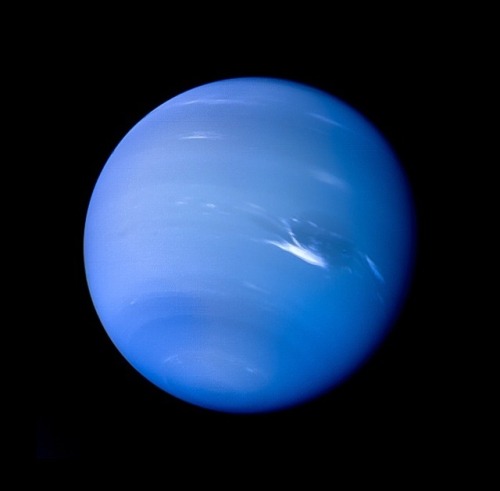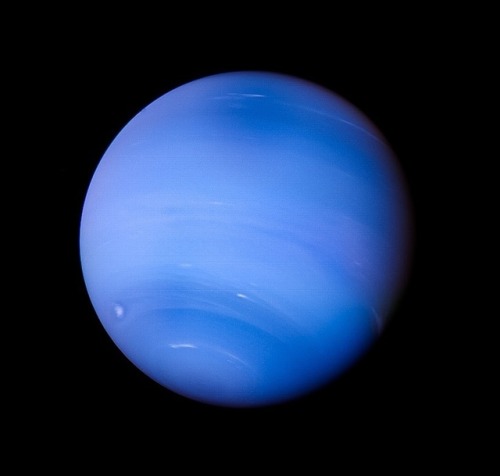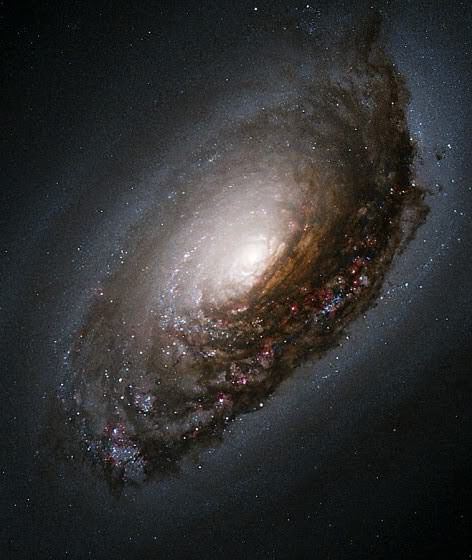Take Your Time. You’ll Get It.
Take your time. You’ll get it.
More Posts from Riekod and Others


images of Neptune taken by Voyager 2 on August 24 1989.
Credit: NASA/JPL-Caltech/Kevin M. Gill

Arp 188 and the Tadpole’s Tail











The Surprising Reason Why Neutron Stars Don’t All Collapse To Form Black Holes
“The measurements of the enormous pressure inside the proton, as well as the distribution of that pressure, show us what’s responsible for preventing the collapse of neutron stars. It’s the internal pressure inside each proton and neutron, arising from the strong force, that holds up neutron stars when white dwarfs have long given out. Determining exactly where that mass threshold is just got a great boost. Rather than solely relying on astrophysical observations, the experimental side of nuclear physics may provide the guidepost we need to theoretically understand where the limits of neutron stars actually lie.”
If you take a large, massive collection of matter and compress it down into a small space, it’s going to attempt to form a black hole. The only thing that can stop it is some sort of internal pressure that pushes back. For stars, that’s thermal, radiation pressure. For white dwarfs, that’s the quantum degeneracy pressure from the electrons. And for neutron stars, there’s quantum degeneracy pressure between the neutrons (or quarks) themselves. Only, if that last case were the only factor at play, neutron stars wouldn’t be able to get more massive than white dwarfs, and there’s strong evidence that they can reach almost twice the Chandrasekhar mass limit of 1.4 solar masses. Instead, there must be a big contribution from the internal pressure each the individual nucleon to resist collapse.
For the first time, we’ve measured that pressure distribution inside the proton, paving the way to understanding why massive neutron stars don’t all form black holes.
Gamma-ray Bursts: Black Hole Birth Announcements
Gamma-ray bursts are the brightest, most violent explosions in the universe, but they can be surprisingly tricky to detect. Our eyes can’t see them because they are tuned to just a limited portion of the types of light that exist, but thanks to technology, we can even see the highest-energy form of light in the cosmos — gamma rays.
So how did we discover gamma-ray bursts?
Accidentally!

We didn’t actually develop gamma-ray detectors to peer at the universe — we were keeping an eye on our neighbors! During the Cold War, the United States and the former Soviet Union both signed the Nuclear Test Ban Treaty of 1963 that stated neither nation would test nuclear weapons in space. Just one week later, the US launched the first Vela satellite to ensure the treaty wasn’t being violated. What they saw instead were gamma-ray events happening out in the cosmos!

Things Going Bump in the Cosmos
Each of these gamma-ray events, dubbed “gamma-ray bursts” or GRBs, lasted such a short time that information was very difficult to gather. For decades their origins, locations and causes remained a cosmic mystery, but in recent years we’ve been able to figure out a lot about GRBs. They come in two flavors: short-duration (less than two seconds) and long-duration (two seconds or more). Short and long bursts seem to be caused by different cosmic events, but the end result is thought to be the birth of a black hole.

Short GRBs are created by binary neutron star mergers. Neutron stars are the superdense leftover cores of really massive stars that have gone supernova. When two of them crash together (long after they’ve gone supernova) the collision releases a spectacular amount of energy before producing a black hole. Astronomers suspect something similar may occur in a merger between a neutron star and an already-existing black hole.

Long GRBs account for most of the bursts we see and can be created when an extremely massive star goes supernova and launches jets of material at nearly the speed of light (though not every supernova will produce a GRB). They can last just a few seconds or several minutes, though some extremely long GRBs have been known to last for hours!

A Gamma-Ray Burst a Day Sends Waves of Light Our Way!
Our Fermi Gamma-ray Space Telescope detects a GRB nearly every day, but there are actually many more happening — we just can’t see them! In a GRB, the gamma rays are shot out in a narrow beam. We have to be lined up just right in order to detect them, because not all bursts are beamed toward us — when we see one it’s because we’re looking right down the barrel of the gamma-ray gun. Scientists estimate that there are at least 50 times more GRBs happening each day than we detect!

So what’s left after a GRB — just a solitary black hole? Since GRBs usually last only a matter of seconds, it’s very difficult to study them in-depth. Fortunately, each one leaves an afterglow that can last for hours or even years in extreme cases. Afterglows are created when the GRB jets run into material surrounding the star. Because that material slows the jets down, we see lower-energy light, like X-rays and radio waves, that can take a while to fade. Afterglows are so important in helping us understand more about GRBs that our Neil Gehrels Swift Observatory was specifically designed to study them!

Last fall, we had the opportunity to learn even more from a gamma-ray burst than usual! From 130 million light-years away, Fermi witnessed a pair of neutron stars collide, creating a spectacular short GRB. What made this burst extra special was the fact that ground-based gravitational wave detectors LIGO and Virgo caught the same event, linking light and gravitational waves to the same source for the first time ever!

For over 10 years now, Fermi has been exploring the gamma-ray universe. Thanks to Fermi, scientists are learning more about the fundamental physics of the cosmos, from dark matter to the nature of space-time and beyond. Discover more about how we’ll be celebrating Fermi’s achievements all year!
Make sure to follow us on Tumblr for your regular dose of space: http://nasa.tumblr.com

M43 - Part of the same star-forming complex as the Great Orion Nebula (M42)
Also being a scientist pretty much gives you a free pass to be as eccentric as you want like you’ll be at a conference and it’s like “is that guy wearing socks and sandals and plaid pants???” “Ya but he was on the team that discovered gravitational waves let him be”

The triple point of water

M64, The Black Eye Galaxy
Stellar Winds
Stellar winds are fast moving flows of material (protons, electrons and atoms of heavier metals) that are ejected from stars. These winds are characterised by a continuous outflow of material moving at speeds anywhere between 20 and 2,000 km/s.

In the case of the Sun, the wind ‘blows’ at a speed of 200 to 300 km/s from quiet regions, and 700 km/s from coronal holes and active regions.

The causes, ejection rates and speeds of stellar winds vary with the mass of the star. In relatively cool, low-mass stars such as the Sun, the wind is caused by the extremely high temperature (millions of degrees Kelvin) of the corona.

his high temperature is thought to be the result of interactions between magnetic fields at the star’s surface, and gives the coronal gas sufficient energy to escape the gravitational attraction of the star as a wind. Stars of this type eject only a tiny fraction of their mass per year as a stellar wind (for example, only 1 part in 1014 of the Sun’s mass is ejected in this way each year), but this still represents losses of millions of tonnes of material each second. Even over their entire lifetime, stars like our Sun lose only a tiny fraction of 1% of their mass through stellar winds.

In contrast, hot, massive stars can produce stellar winds a billion times stronger than those of low-mass stars. Over their short lifetimes, they can eject many solar masses (perhaps up to 50% of their initial mass) of material in the form of 2,000 km/sec winds.

These stellar winds are driven directly by the radiation pressure from photons escaping the star. In some cases, high-mass stars can eject virtually all of their outer envelopes in winds. The result is a Wolf-Rayet star.

Stellar winds play an important part in the chemical evolution of the Universe, as they carry dust and metals back into the interstellar medium where they will be incorporated into the next generation of stars.
source (read more) + Wolf–Rayet star
-
 eclectictastenerd liked this · 4 years ago
eclectictastenerd liked this · 4 years ago -
 fairiegardens liked this · 5 years ago
fairiegardens liked this · 5 years ago -
 moonbroth liked this · 5 years ago
moonbroth liked this · 5 years ago -
 keepthatfeel liked this · 5 years ago
keepthatfeel liked this · 5 years ago -
 bluesardine reblogged this · 5 years ago
bluesardine reblogged this · 5 years ago -
 vanessainstem reblogged this · 5 years ago
vanessainstem reblogged this · 5 years ago -
 vanessainstem liked this · 5 years ago
vanessainstem liked this · 5 years ago -
 gingertiger52 liked this · 5 years ago
gingertiger52 liked this · 5 years ago -
 deadgardens liked this · 5 years ago
deadgardens liked this · 5 years ago -
 verdecomoelte reblogged this · 5 years ago
verdecomoelte reblogged this · 5 years ago -
 iamannyya liked this · 6 years ago
iamannyya liked this · 6 years ago -
 maudlinskyy liked this · 6 years ago
maudlinskyy liked this · 6 years ago -
 raoykanray liked this · 6 years ago
raoykanray liked this · 6 years ago -
 magont liked this · 6 years ago
magont liked this · 6 years ago -
 the-angelic-mochi liked this · 6 years ago
the-angelic-mochi liked this · 6 years ago -
 theportabledoor reblogged this · 6 years ago
theportabledoor reblogged this · 6 years ago -
 riekod reblogged this · 6 years ago
riekod reblogged this · 6 years ago -
 varvesivy liked this · 6 years ago
varvesivy liked this · 6 years ago -
 enthusiasticstarprincess-blog liked this · 6 years ago
enthusiasticstarprincess-blog liked this · 6 years ago -
 jocolatemousse liked this · 6 years ago
jocolatemousse liked this · 6 years ago -
 vivalasestrellas reblogged this · 6 years ago
vivalasestrellas reblogged this · 6 years ago -
 vivalasestrellas liked this · 6 years ago
vivalasestrellas liked this · 6 years ago -
 toasterunderthesea liked this · 6 years ago
toasterunderthesea liked this · 6 years ago -
 mohaine liked this · 6 years ago
mohaine liked this · 6 years ago -
 vacuously-true reblogged this · 6 years ago
vacuously-true reblogged this · 6 years ago -
 throwaysaucer liked this · 6 years ago
throwaysaucer liked this · 6 years ago -
 thenathannator liked this · 6 years ago
thenathannator liked this · 6 years ago -
 hippiephysicist liked this · 6 years ago
hippiephysicist liked this · 6 years ago -
 au-talent reblogged this · 6 years ago
au-talent reblogged this · 6 years ago -
 calqulus-blog liked this · 6 years ago
calqulus-blog liked this · 6 years ago -
 siqk0 liked this · 6 years ago
siqk0 liked this · 6 years ago -
 shiver09 liked this · 6 years ago
shiver09 liked this · 6 years ago -
 irkoworld reblogged this · 6 years ago
irkoworld reblogged this · 6 years ago -
 irkoworld liked this · 6 years ago
irkoworld liked this · 6 years ago -
 wow-shut-up reblogged this · 6 years ago
wow-shut-up reblogged this · 6 years ago